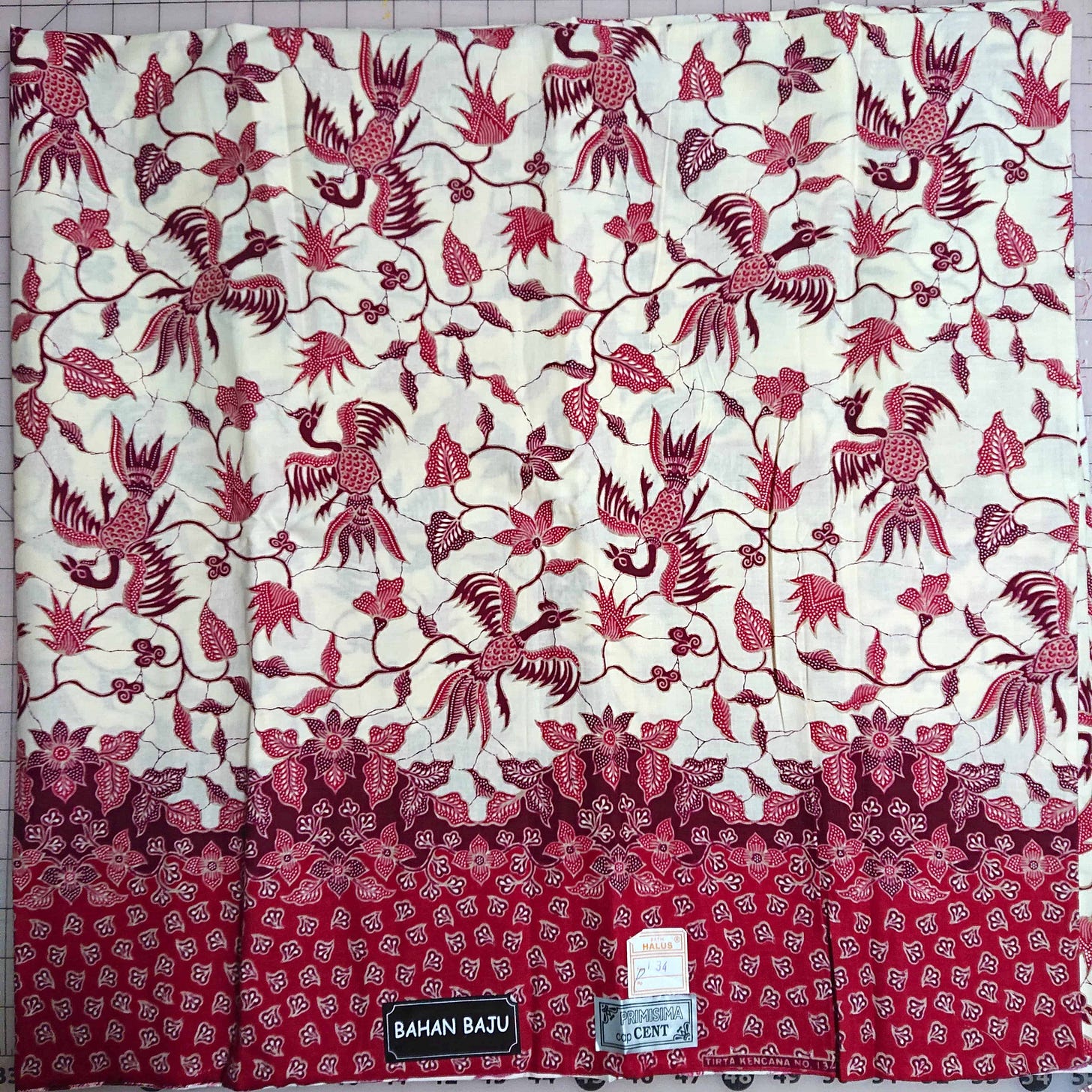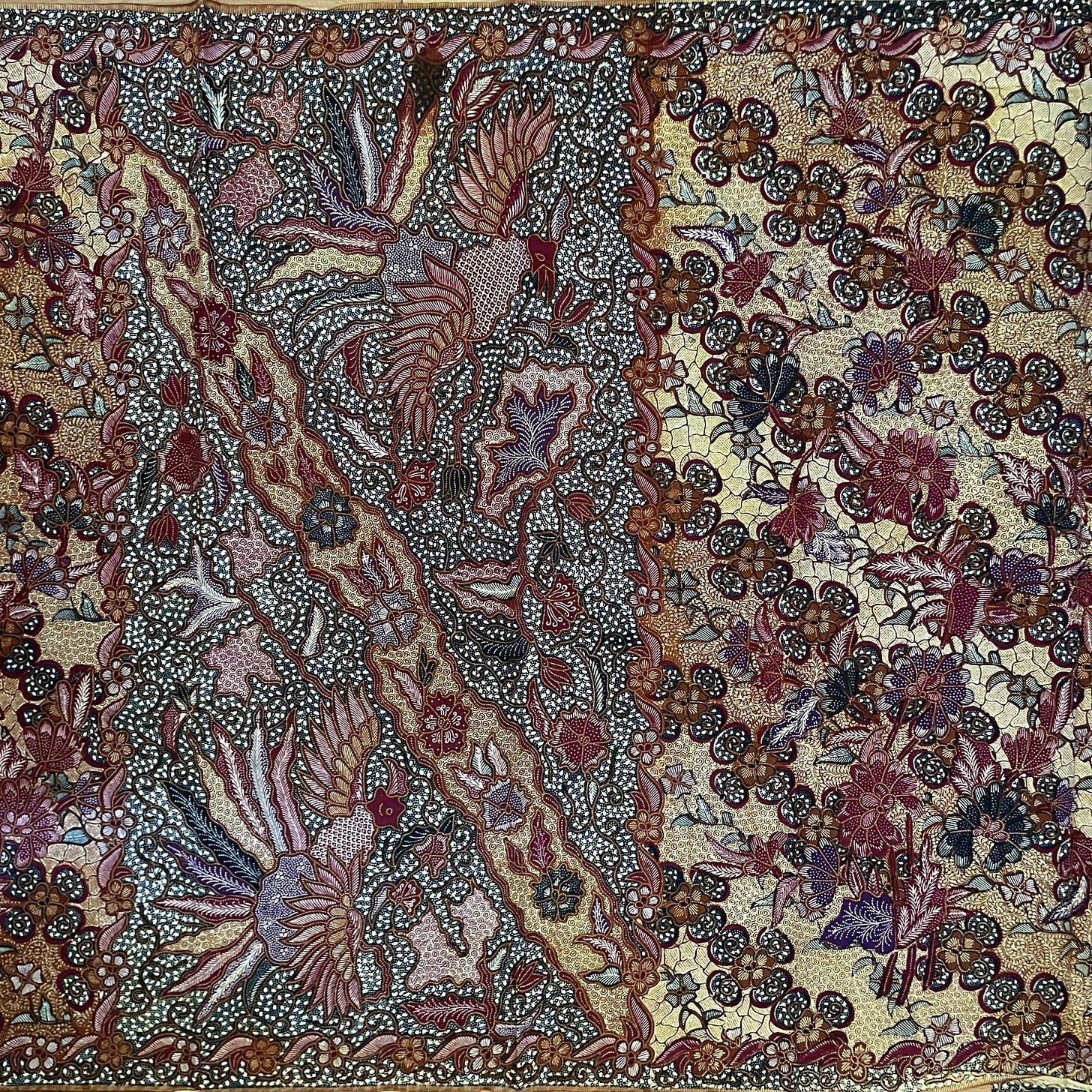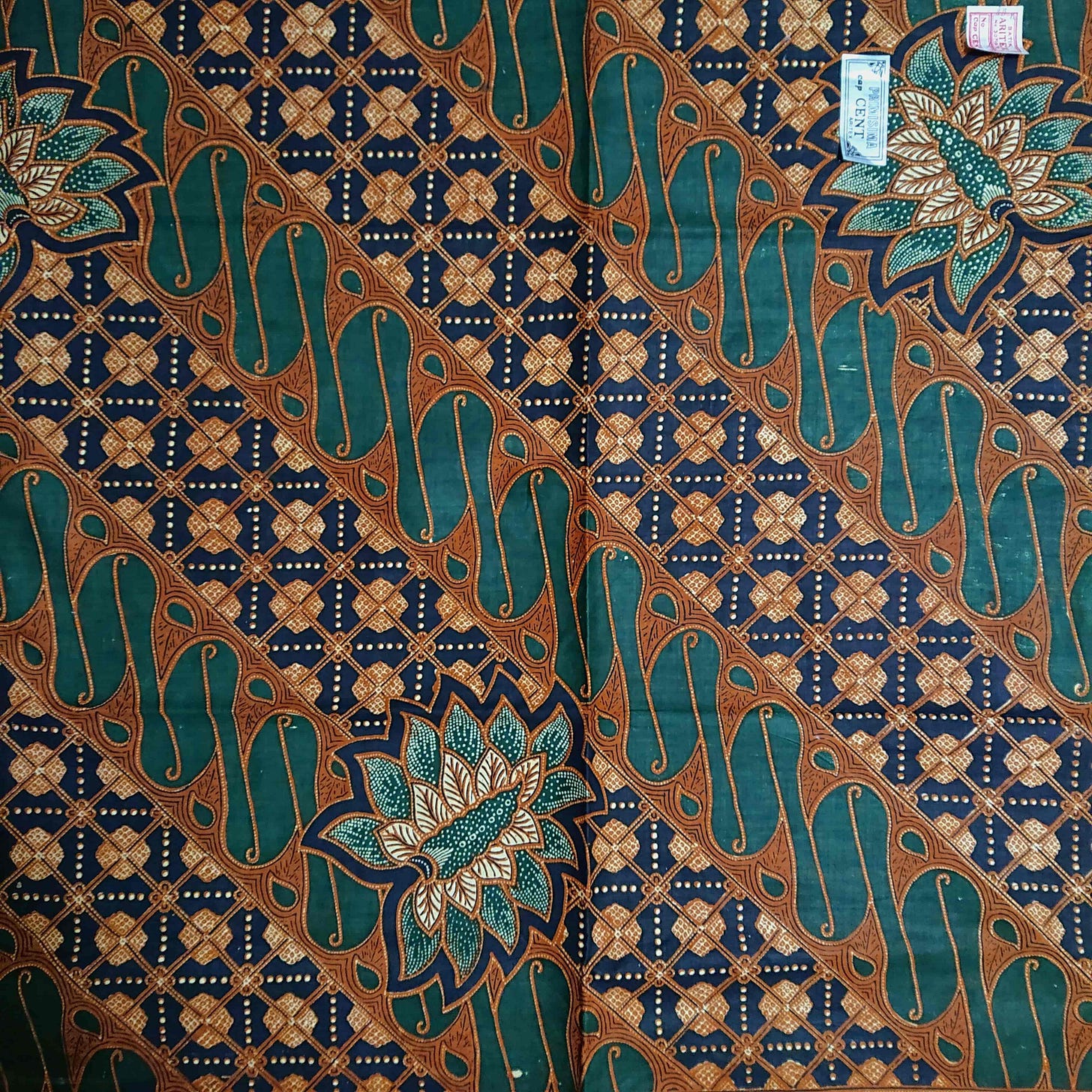Batik Storytelling Continued: Lung-lungan, Parang, and More
Diagonal lines are slimming, but be mindful when choosing motifs to wear
Hello hello! Welcome to Part 2 of my “Batik Storytelling: Decoding the Motifs of Javanese Textile Art” series. We’re going to continue where we left off last time. So if you’re feeling lost and missed Part 1, you are welcomed to read it first to establish necessary context. But if you just want to wing it anyway, be my guest!
Rooster Lung-lungan
If you read last week’s newsletter, you’d know by now that lung-lungan is a very popular motif in Javanese Batik culture. The interlocking curling lily flowers and leaves give an attractive, neat background to the stylized roosters. Lilies are amongst the most popular flowers to draw in Javanese Batik culture.
Just like last week’s phoenix lung-lungan and flowers with truntum background textiles, this piece comes from Solo, albeit from a different store. It’s marked “Batik Halus Sri Ratu” and it is slightly coarser than the ones from Batik Keris store.
The age is similar to the other two, likely purchased in the mid 1990s. The quality suggests that it’s made using the Batik Cap method, i.e. stamping with copper or steel blocks.
Rooster symbolizes the sun, optimism, and confidence. The lilies are also associated with the sun, which is seen as a God symbol, the life-giving energy. Therefore, it encourages the wearer to develop a good relationship with the higher power.
It also symbolizes beginning of new life, and the lung-lungan pattern only amps it more with synergy and interdependence. To help each other and to foster collaboration between players.
It should come as no surprise that this particular piece of Javanese Batik textile is good to wear during weddings and love-celebrating events. Just like phoenix lung-lungan and flowers with truntum background pieces, they provide facets of love and joy in distinct visual expressions.
Red Lung-lungan “Terang Bulan”
This unique Javanese Batik piece is a gift from my Mom. While it’s purchased in Yogyakarta in the mid 2000s, I’m quite convinced that it’s produced elsewhere. Its use of red color, as well as the delicate stylized birds and lung-lungan design are characteristic of Tasikmalaya, a Javanese Batik producer located 120 km (74.5 miles) south-east of Bandung on the road leading to Yogyakarta. The repeat pattern indicates that it’s made with Batik Cap method, however it’s also possible that the motifs are then resurfaced and traced with canting, which is a Batik Tulis method.
The contrasting background of white and wide red-based undulating background on the lower half is a design called terang bulan (moonlight). Terang bulan design depicts a scene of joy and celebration during the full moon, when living beings rejoice and give thanks to the Almighty.
I couldn’t identify the flower and plant lung-lungan species, and I’m not too sure about the animal, either. My best guess is they are stylized cendrawasih (bird of paradise), which are linked to Phoenix, a mythical bird that only appears in times of prosperity.
The whole scene of this Javanese Batik piece is both a symbol of joy, happiness, and celebration of life. Underneath it all, the lung-lungan and terang bulan design set the underlying reminder that we need to always remember where we come from, to help each other, and to give thanks to the God above.
Rooster Lereng
Let me just say that I’m stumped with this beautiful Javanese Batik piece. I have never seen a piece so bright and densely filled, exuberant and alive. The use of colors is also very bold.
Being used to seeing pieces made in Solo, Yogyakarta, and Pekalongan, I don’t think I’ve ever seen something like this before in my life. And despite my attempts to get opinions from Batik experts based in either Jakarta, Indonesia or the Bay Area, California, USA, I have yet to get a definitive answer.
If you are a Javanese Batik lover and have some ideas about where this piece is from, please reach out to me or leave a comment!
My best guess about this piece’s origin is Pekalongan, based on how bright this piece is, as well as the bold use of colors. However, the stylized roosters and heavy use of flower motifs are also characteristic of Madura, an island in East Java and one of the biggest producers of Javanese Batik.
As you can see, there’s a distinct separation of design, the framed roosters on the left as kepala (head), and the diagonal bands of stylized flowers and tendrils everywhere else as badan (body). If you wear this Batik piece around your lower half, the kepala part is meant to be showcased on the outside, towards the front. This kepala - badan style is an influence from the Europeans or the Chinese.
Lereng (directly translates to steep slope) refers to the diagonal bands. Lereng composition in Batik making is popular, as they are seen to be visually striking, have a slimming effect, and is considered a bringer of good fortune. On this piece, the diagonal bands have alternating motifs of curling flowers and plant tendrils, with the flowers acting as the borders between the lanes.
The bold roosters and curling flower motifs symbolize the sun, optimism, confidence, and fertility. While this piece is very pretty and suitable for all genders, it feels very masculine at the same time. That said, remember everything I write is my interpretation, a response to observations of high-art textiles known as Javanese Batik.
Flower Bouquet
This is another example of kepala - badan style, this time using a flower bouquet motif. This style is characteristic of Javanese Peranakan style (Javanese origin with Chinese descent), and it’s also a popular choice amongst Europeans. The flowers are peonies and chrysanthemums, indicators of love, happiness, good luck, and joyful marriage.
I bought this flower bouquet kepala - badan sarong in Yogyakarta last year from a Solo merchant, however this is a product of Pekalongan. This piece is made by Batik Cetak (printed) method, which is a controversial mass-produced version of Batik. I will speak more on this matter at the end of this newsletter.
Parang with ceplok background
Let’s go back to the lereng design category, this time focusing on parang motifs. This piece is most likely made in Solo circa 1990s, showcasing elegant S-shaped waves arranged on neat diagonal lines on top of ceplok (geometric background) pattern. This parang pattern seems bigger than common-sized ones, so I’d say this is a parang barong motif, which symbolizes wisdom. Some stylized leaves are shown on the foreground, its species I cannot identify.
Parang motif is one the oldest patterns in Java, and its popularity endures until now. It’s also rich with symbolism and class hierarchy. Its use was reserved only for royalty in the olden days, and it’s still a strictly regulated motif for its usage amongst royalties residing in central courts of Java. When you visit the Court of Yogyakarta, parang pattern is amongst the forbidden Batik motifs to wear.
This sacred symbolism was confirmed during my last visit to Central Java last year. During the guided tour at Museum Ullen Sentalu, the guide said that if you choose to wear parang motifs to visit the Court of Yogyakarta, you wouldn’t be allowed to go in. You will be seen as an unwanted challenger of the one in charge of power, Sri Sultan Hamengkubuwono X. So unless you are looking for trouble, don’t do it!
There are two versions of the parang origin. Rouffaer & Juynboll wrote that it refers to blades that warriors and soldiers carry when they battle. When they wear this motif, it’s believed that their power would multiply.
The other theory states Panembahan Senapati as the creator of the parang motif, as he observed the wave movements of the Southern Sea as they crashed the coral rocks on the beach. The ocean waves symbolize the center of inner energy, which relates to the king’s position.
Parang Klitik
It’s hard to discern without seeing the textile pieces in person, however this beautiful Batik Sogan made in Solo features small (smaller than normal) parang arrangements. Thus the name parang klitik. This one is explicitly marked to be made with a combination of Batik Cap and Batik Tulis methods.
You would be surprised to see the abundant variety of parang motifs, each with its own set of symbolisms. Parang klitik symbolizes traditional feminine qualities: soft manners and wisdom. In the olden days, it’s a motif reserved for princesses.
I saw one site that lists this motif as parang kusuma, which has another meaning. It symbolizes a neverending, harmonious bond. It encourages us to always better ourselves and form a strong, healthy family relation.
There’s a myth that forbids wearing parang kusuma at weddings. When guests wear this motif, it’s believed that it would bring sial (bad luck) to the bride and groom. However, this myth directly contradicts the motif’s meaning, which encourages strong familial bonds.
Controversies around Batik Cetak
To close this newsletter, I’d like to comment on the controversial nature of Batik Cetak (printed batik). This mass-market way to produce Batik is very common. Nowadays, affordable Batik Cetak products are readily available and saturated most markets - both traditional and modern. Fabrics are printed with Batik motifs using synthetic inks, produced efficiently and cheaply.
Does it sound familiar with the West’s current “battle” between slow and fast (and ultra fast) fashion? Because it is.
Practitioners of Batik, who dedicate time and effort to create Batik Tulis and Batik Cap don’t look at Batik Cetak kindly, saying it’s not Batik. The instant production nature doesn’t nurture or encourage preservation and evolution of the art through skill sharing or teaching to the younger generations, ultimately ruining the Batik heritage. Many fear the disappearing high art of Javanese Batik, and there are local initiatives to revive / nurture Batik craftsmanship in Java.
There is an Indonesian saying “Ada harga, ada barang.” This means the price of the Batik product dictates the kind of product you’ll get. Batik Tulis, which takes at least one month to make for the simplest motifs, and up to 2 years or more for more complex designs, is sold at the highest price tier, from hundreds of thousand to millions rupiahs. Batik Cap, made with the more efficient stamping method, typically sells for hundreds of thousand rupiahs. Batik Cetak is typically sold at tens of thousand rupiahs.
Because of Batik Cetak's popularity, many Batik houses will sell them. Danar Hadi, one of the most renowned Batik brands in Java, sells printed batik in good quality, like this green one with ceplok motifs shown above and below.

There’s also the tendency to use “Batik Tulis” wording even though it’s clearly a Batik Cetak, like the kepala - badan style below. This Yogyakarta style, made in Solo printed batik piece has a label that includes “Batik Tulis Halus” (Batik Tulis with a soft hand) on the label.
However, it’s sold cheaply at tens of thousand rupiahs, which indicates its actual printed batik category. This kind of misinformation is rampant and largely unregulated, so people may use the term “Batik Tulis” carelessly without giving a second thought about its making process.

That’s it for this week! Next week, on the last AAPI Heritage Month Celebration issue, I will share some more Batik motifs, as well as my collection of Batik garments. Some bought, some I made myself, and some are in the process of getting transformed into garments. Stay tuned.
Thanks for reading; until next time,
Mira Musank
Special Acknowledgements:
Thank you Mary Connors from Textile Arts Council for her excellent reading recommendations:
Indonesian Batik - Processes, Patterns and Places by Sylvia Fraser Lu
Fabric of Enchantment - Batik from the North Coast of Java by Rens Heringa and Harmen C. Veldhuisen
If you have more Indonesian or Javanese batik reading recommendations, please chime in and I’ll add it to the list!
Additional sources:
Info Batik (in Indonesian)
Indonesia Kaya - Batik, Khazanah Nusantara untuk Dunia (in Indonesian)
The Sociological Review - Batik: Behind A Textile by Melike Sima Alişan (2020)
University of Oslo - Design Traditions – the Javanese Heritage
Tempo.co - Hari Batik Nasional, Ketahui Bagaimana Proses Membuat Batik Beserta Jenisnya by Rini Kustiani (2021) (in Indonesian)
Asian Art Museum - Batik: Spectacular Textiles of Java (2013 exhibition)
Art of the Ancestors - Javanese Batik Textiles at St. Louis Art Museum (2019)










Also, if you want to see Javanese Batik in motion picture, check out Cigarette Girl on Netflix! Everything the characters wear inform their identity and values. See if you can decode the presented Batik motifs in this excellent series:
https://www.netflix.com/title/81476989